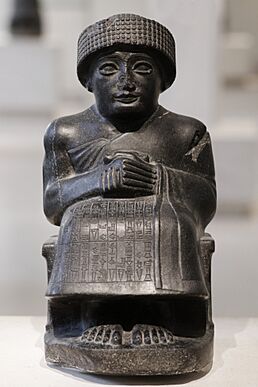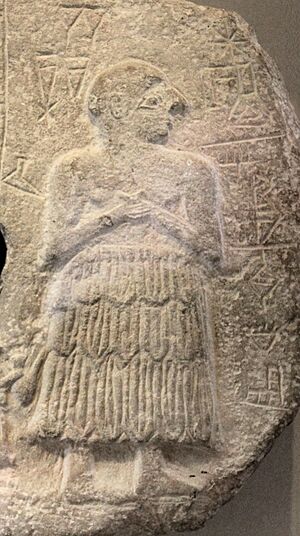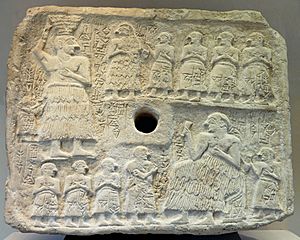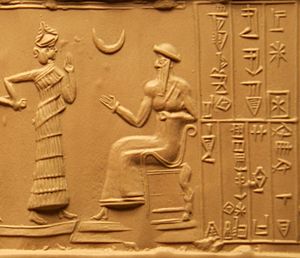History of Sumer facts for kids
The history of Sumer tells the story of an ancient civilization in southern Mesopotamia. This history covers a long time, from about 5000 BCE to 2000 BCE. Sumer was the very first known civilization in this area. Its story ended when the Third Dynasty of Ur fell around 2004 BCE. After Sumer, other groups like the Amorites took over, and later, Babylonia became powerful in the 18th century BCE.
The oldest known settlement in southern Mesopotamia is called Tell el-'Oueili. The Sumerians believed their civilization was given to them by their god Enki or his helper, Adapa U-an. The first people in the city of Eridu brought the Samarra culture from northern Mesopotamia. These early times are known as the Ubaid period. We don't know for sure if these first people were Sumerians, who are later linked with the Uruk period.
Contents
Sumer's Timeline: Key Periods

-
-
- Dates are close estimates. Check specific articles for more details.
- Uruk III is also known as the Jemdet Nasr period.
-
Sumer's First Cities

People started living in cities all year round because of farming. They needed to work together to keep irrigation canals clean. This teamwork and the extra food they grew allowed more people to live closer together.
The cities of Eridu and Uruk were among the first. They built large temple complexes out of mud bricks. These started as small shrines. Over time, they grew into the biggest buildings in each city. Each temple was dedicated to a specific god.
Here are some of the main temple-cities, their temples, and the gods they worshipped:
- Eridu, E-Abzu, for Enki
- Ur, E-kishnugal, for Nanna (the moon god)
- Larsa, E-babbar, for Utu (the sun god)
- Uruk, E-anna, for Inana and An
- Nippur, E-kur, for Enlil
- Kish, for Ninhursag
- Sippar, E-babbar, for Utu (the sun god)
Before 3000 BCE, a priest-king called an ensi led the city. He was helped by a group of older leaders. These leaders were based in the temples. We don't know exactly how cities started to have non-religious rulers.
The way cities were run led to the invention of writing. Early clay tablets appeared around 3500–3200 BCE. Ideographic writing (pictures representing ideas) developed around 3100 BCE. This then became logographic writing (symbols representing words) around 2500 BCE.
Historians find it hard to date the very first cuneiform texts. This is because most tablets were found in old rubbish heaps. These old tablets were used as filler for new buildings. So, it's tough to know exactly when they were written.
Still, experts believe writing developed in stages:

-
-
- A : around 3400 BCE : numbers on a tablet; B : around 3300 BCE : numbers with logograms (word-symbols);
C : around 3240 BCE : early writing with phonograms (sound-symbols); D : around 3000 BCE : full writing system.
- A : around 3400 BCE : numbers on a tablet; B : around 3300 BCE : numbers with logograms (word-symbols);
-
Sumerian History: Key Periods
Early Times and Beginnings
The early history of southern Mesopotamia is split into three periods:
- The Ubaid period (around 6500–3800 BC)
- The Uruk period (around 4000 to 3100 BC)
- The Jemdet Nasr period (around 3100 to 2900 BC)
Experts disagree on when Sumerians first arrived. Some think they came around 3600 BC. Others believe they were there much earlier, even before the Ubaid period. However, most agree that the Sumerian language was spoken in southern Mesopotamia by the end of the Uruk period.
Early Dynastic Period: City-States Rise
The Early Dynastic Period started around 2900 BC. This was after a big change from the Jemdet Nasr period. We haven't found any writings from the very first part of this period (Early Dynastic I) that name kings.
The Early Dynastic II period is when Gilgamesh, the famous king of Uruk, is thought to have ruled. Writings from this time are still hard to understand. Later writings do mention some kings from the Early Dynastic II period, found in the Sumerian King List.
Full syllabic writing (where symbols represent sounds) began in the Early Dynastic IIIa period, also called the Fara period. Before this, there were accounting records and a script that used word-symbols. But human speech was first fully written down around 2600 BC. The Early Dynastic IIIb period is also known as the Pre-Sargonic period.
During this time, power often shifted between different Sumerian city-states. These included Kish, Uruk, Ur, Adab, and Akshak. Sometimes, cities from outside Sumer, like Awan and Mari, also held power. This continued until the Akkadians, led by Sargon of Akkad, took control of the whole area.
Kish: The First Dynasty
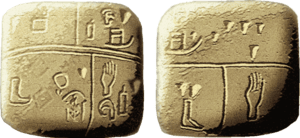
The earliest king from Kish mentioned in legends is Etana. He was called "the shepherd, who went to heaven and united all foreign lands." He is thought to have lived around 3000 BC. Many kings after him had Semitic Akkadian names. This suggests that many people in this northern city spoke Akkadian.
The first king whose existence is proven by archaeological finds is En-me-barage-si of Kish (around 2600 BC). He is said to have defeated Elam and built a temple in Nippur. His successor, Aga, is said to have fought with Gilgamesh of Uruk. For a while after this, Uruk seemed to be the most powerful city in Sumer. The Sumerian king list can be tricky because kings who lived at the same time are sometimes listed in different dynasties.
Uruk: The First Dynasty
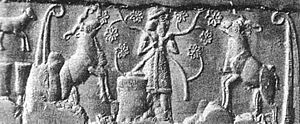
Mesh-ki-ang-gasher is listed as the first King of Uruk. He was followed by Enmerkar. An old story, Enmerkar and the Lord of Aratta, tells of Enmerkar's journey to Aratta, a land rich in minerals. Next came Lugalbanda, also known from old stories, and then Dumuzid, the Fisherman.
The most famous king of this dynasty was Gilgamesh, Dumuzid's successor. He is the hero of the Epic of Gilgamesh. This epic calls him Lugalbanda's son. Old copies of this story have been found in places like Hattusas, Megiddo, and Tell el Amarna.
Ur: The First Dynasty
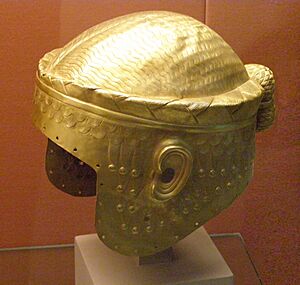
This dynasty ruled around the 26th century BC. Meskalamdug is the first king (called Lugal, meaning "big man") of Ur found in archaeological records. His son Akalamdug followed him, and then Akalamdug's son, Mesh-Ane-pada.
Mesh-Ane-pada is the first king of Ur listed in the king list. It says he defeated Lugalkildu of Uruk. He also seems to have taken control of Kish, calling himself "King of Kish." Many powerful kings after him used this title.
King Mesilim of Kish is known from writings that say he built temples in Lagash and Adab. He also helped settle a border dispute between Lagash and its rival, Umma. We don't know exactly when Mesilim ruled compared to Mesh-Ane-pada.
Awan: A Brief Rule
This dynasty is from the 26th century BC. According to the Sumerian king list, Elam, Sumer's neighbor to the east, briefly held power in Sumer from the city of Awan.
Uruk: The Second Dynasty
- Further information: Uruk
Enshakushanna was a king of Uruk in the later 3rd millennium BC. The Sumerian king list says he ruled for 60 years. He was followed by Lugal-kinishe-dudu in Uruk. However, power seemed to shift briefly to Eannatum of Lagash.
Lugal-Ane-mundu's Empire from Adab
After this, a Sumerian conqueror from Adab, Lugal-Ane-mundu, seemed to control much of Mesopotamia. He ruled over Uruk, Ur, and Lagash. Writings say his kingdom stretched from the Persian Gulf to the Mediterranean Sea, and up to the Zagros Mountains, including Elam. But his empire fell apart when he died. The king list says Mari in Upper Mesopotamia was the next city to hold power.
Kish: Kug-Bau and the Third Dynasty
The Third Dynasty of Kish had only one ruler listed: Kug-Bau or Kubaba. She is special because she was the only woman named as "king" on the king list. It says she was a tavern keeper before she took power from Mari and became queen. Later, people worshipped her as a minor goddess. She became very important in later cultures.
Lagash: The First Dynasty
- Further information: Lagash
This dynasty is from the 25th century BC. En-hegal was the first known ruler of Lagash. He paid tribute to Uruk. His successor, Lugal-sha-engur, also paid tribute to Mesilim. After Mesannepada of Ur held power, Ur-Nanshe became the new high priest of Lagash. He gained independence and made himself king. He defeated Ur and captured the king of Umma.
Archaeologists found clay carvings of Ur-Nanshe and his sons, along with other beautiful items. One writing says that ships from Dilmun (modern Bahrain) brought him wood as tribute. His son Akurgal followed him.
Eannatum, Ur-Nanshe's grandson, took control of all of Sumer. This included Uruk, Ur, Nippur, Akshak, and Larsa. He also took over Kish, but it became independent again after he died. Umma had to pay tribute to Lagash. Eannatum also fought outside Sumer, taking part of Elam and the city of Az on the Persian Gulf. He even collected tribute from as far as Mari. However, many of the lands he conquered often rebelled.
During his rule, temples and palaces were fixed or built in Lagash. The town of Nina was rebuilt, and new canals and water storage areas were dug. Eannatum was followed by his brother, En-anna-tum I. During his time, Umma tried to become independent again under Ur-Lumma, who attacked Lagash but failed. Ur-Lumma was replaced by a priest-king, Illi, who also attacked Lagash.
His son and successor, Entemena, brought back Lagash's power. Illi of Umma was defeated with help from Entemena's ally, Lugal-kinishe-dudu of Uruk. Lugal-kinishe-dudu seemed very important at the time, as he also claimed to rule Kish and Ur.
A silver vase dedicated by Entemena to his god is now in the Louvre museum. It shows amazing artistic skill. This vase proves how good goldsmiths were back then. Another vase, made of calcite, was also dedicated by Entemena. After Entemena, Lagash had a series of weaker priest-kings. The last of these, Urukagina, was known for his fair laws and changes. His might be the first known legal code.
Lugal-zage-si's Empire from Uruk
Urukagina (around 2359–2335 BC) was overthrown. His city, Lagash, was captured by Lugal-zage-si, the high priest of Umma. Lugal-zage-si also took Uruk and Ur, making Uruk his capital. In a long inscription, he boasted that his kingdom stretched "from the Lower Sea (Persian Gulf), along the Tigris and Euphrates rivers, to the Upper Sea" (the Mediterranean). His empire was later defeated by Sargon of Akkad.
Akkadian Empire: A New Power
The Akkadian period lasted from about 2334–2147 BC. Here are some of the known kings from this time:
| Sargon | around 2334–2279 BC | |
| Rimush | around 2278–2270 BC | Sargon's younger son |
| Man-ishtishu | around 2269–2255 BC | Sargon's older son |
| Naram-Sin | around 2254–2218 BC | Man-ishtishu's son |
| Shar-kali-sharri | around 2217–2193 BC | Naram-Suen's son |
| Dudu | around 2189–2168 BC | |
| Shu-Durul | around 2168–2147 BC | Akkad was defeated by the Gutians |
Gutian Period: A Time of Change
After Sargon's Empire fell to the Gutians, there was a short "Dark Ages." This period lasted from about 2141–2050 BC.
Lagash: The Second Dynasty

This period lasted from about 2260–2110 BC.
| Puzer-Mama | around 2200 BC | lived at the same time as Shar-kali-sharri of Akkad |
| Ur-Bau or Ur-baba | around 2093–2080 BC | |
| Gudea | around 2080–2060 BC | Ur-baba's son-in-law |
| Ur-Ningirsu | around 2060–2055 BC | Gudea's son |
| Nammahani | around 2049–2046 BC | defeated by Ur-Nammu |
Uruk: The Fifth Dynasty
This dynasty lasted between about 2055–2048 BC. The Gutians were finally driven out by the Sumerians under Utu-hegal. He was the only king of this dynasty. He was then defeated by Ur-Nammu of Ur.
Ur: The Third Dynasty
The Third Dynasty of Ur is dated to about 2047–1940 BC. Ur-Nammu of Ur defeated Utu-hegal of Uruk and started this dynasty. Even though the Sumerian language was made official again, Sumerian identity was slowly fading. People were becoming more like the Akkadians (Assyrians and Babylonians).
The Ur III dynasty was destroyed by the Elamites in 2004 BC. After this, a strong rivalry grew between the city-states of Larsa and Isin. Larsa was more influenced by Elam, while Isin was more Amorite (a group of Western Semitic nomads).
By the time of Hammurabi of Babylon, who started the Babylonian Empire, the Semitic people had taken over Mesopotamia. The Sumerian language and name slowly became something only studied by scholars. However, Sumerian culture had a huge impact on Babylonia and all later cultures in the region.
Over time, the Sumerian and Akkadian cultures mixed closely. Many people spoke both languages. The Sumerian language greatly influenced Akkadian, and vice versa. They borrowed many words from each other.
Akkadian slowly replaced Sumerian as the main spoken language in Mesopotamia around 2000 BC. But Sumerian continued to be used for religious ceremonies, literature, and science until the first century AD.
More to Explore
- History of Mesopotamia
- List of Mesopotamian dynasties


